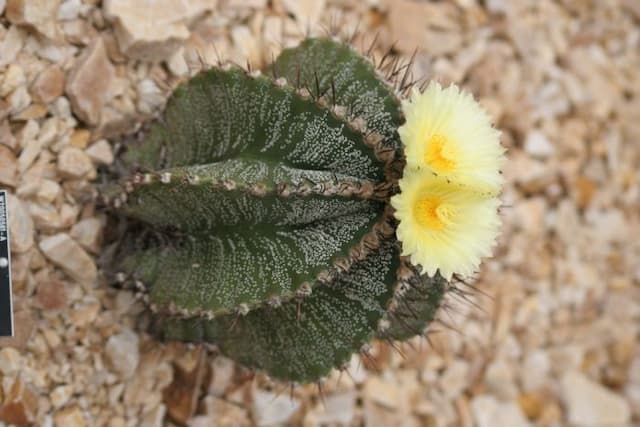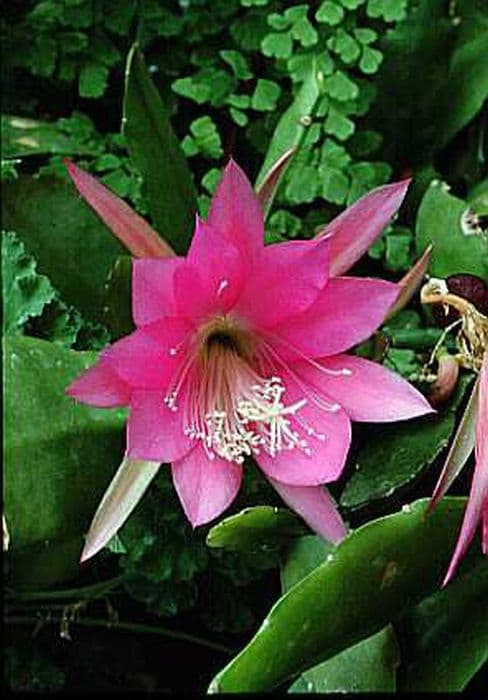Chin Cactus Gymnocalycium oenanthemum

ABOUT
This plant, commonly known as the chin cactus, is a small, globular species with a green to blue-green body. Its surface is divided into several vertical ribs, which are adorned with areoles from which sharp, needle-like spines emerge. The spines can vary in color from white to yellow or even brown, adding to the plant's decorative appearance. During blooming season, it produces attractive flowers that sprout near the plant's crown. These flowers are typically funnel-shaped and can show a range of colors from white to pink. Its overall aesthetic is one that is rugged yet delicate, due to the contrast between its spiny defenses and its blossoming flowers.
About this plant
 Names
NamesFamily
Cactaceae
Synonyms
Violet Chin Cactus, Purple Moon Cactus
Common names
Gymnocalycium oenanthemum.
 Toxicity
ToxicityTo humans
Gymnocalycium oenanthemum, commonly known as Chin Cactus, is not known to be toxic to humans. Consuming parts of this plant is not typically associated with poisoning or adverse symptoms.
To pets
Chin Cactus is not known to be toxic to pets. It is not typically associated with poisoning in animals, and ingesting parts of this plant does not normally result in adverse symptoms. However, caution should still be exercised to prevent ingestion, as non-toxic plants can sometimes cause gastrointestinal upset in pets.
 Characteristics
CharacteristicsLife cycle
Perennials
Foliage type
Evergreen
Color of leaves
Green
Flower color
Varies
Height
6 inches (15 cm)
Spread
6 inches (15 cm)
Plant type
Cactus
Hardiness zones
9
Native area
South America
Benefits
 General Benefits
General Benefits- Decorative Appeal - Adds aesthetic value to homes and gardens with its unique shape and varied colors.
- Low Maintenance - Requires minimal care, making it ideal for busy individuals or those new to gardening.
- Drought Resistant - Suited for arid climates due to its ability to retain water and thrive with infrequent watering.
- Temperature Resilient - Can tolerate a range of temperatures, adapting to indoor and outdoor environments.
- Long Lifespan - With proper care, it can live for many years, providing long-term enjoyment.
- Pest Resistant - Generally resistant to common pests, reducing the need for chemical treatments.
- Space-Efficient - Compact size makes it suitable for small spaces such as windowsills and desks.
- Gift Potential - Popular as a gift due to its unique appearance and ease of care.
- Educational - Can be used to teach about plant growth and cactus care in educational settings.
 Medical Properties
Medical PropertiesThis plant is not used for medical purposes.
 Air-purifying Qualities
Air-purifying QualitiesThis plant is not specifically known for air purifying qualities.
 Other Uses
Other Uses- Gymnocalycium oenanthemum, commonly known as Chin Cactus, can often be used as a subject in macro photography because of its interesting patterns and spines, allowing enthusiasts to capture the intricate details that are characteristic of cacti.
- Chin Cactus, with its symmetrical and spiral growth patterns, is sometimes utilized as a model to help teach mathematical concepts such as the Fibonacci sequence, which frequently appears in nature.
- The plant can serve as a natural barometer, as some cacti close up their flowers or change their positions according to weather changes.
- It is sometimes incorporated into drought-tolerant landscapes as part of xeriscaping, which reduces the need for water irrigation.
- Among hobbyist circles, Chin Cactus is valued for the practice of grafting, where it is used as a rootstock for grafting other, more sensitive or slower-growing cactus species due to its robust nature.
- This plant can be used in educational settings for botany studies that focus on adaptation and evolution of plants in arid environments.
- Chin Cactus can be used in cultural ceremonies or symbolism, particularly where plants represent resilience and the ability to thrive in challenging environments.
- In Feng Shui and similar practices, it is occasionally suggested that spiny plants like Chin Cactus can protect a home from negative energies when placed near the entrance.
- Cacti enthusiasts may use Chin Cactus in competitive horticulture events, where plants are judged on their health, rarity, and adherence to species' standards.
- Due to its low water needs and ability to grow in harsh conditions, the Chin Cactus can be part of educational kits on sustainable gardening and conservation efforts.
Interesting Facts
 Feng Shui
Feng ShuiThe Gymnocalycium oenanthemum, commonly known as the Chin Cactus, is not used in Feng Shui practice.
 Zodiac Sign Compitability
Zodiac Sign CompitabilityThe Chin Cactus is not used in astrology practice.
 Plant Symbolism
Plant Symbolism- Resilience: Gymnocalycium oenanthemum, commonly known as Chin Cactus, often symbolizes resilience due to its ability to thrive in arid environments and to store water for survival during droughts.
- Beauty in Adversity: The Chin Cactus, with its attractive flowers that bloom even in harsh conditions, represents finding beauty amidst challenging circumstances.
- Adaptability: This cactus represents adaptability, as it is capable of adjusting to extreme changes in its environment, such as temperature fluctuations and moisture levels.
 Water
WaterFor the Chin Cactus (Gymnocalycium oenanthemum), water thoroughly when the soil is completely dry, usually once every 7 to 10 days during the active growing season in spring and summer. In cooler months, reduce watering to once every 4 to 6 weeks. It is crucial to avoid overwatering as this can lead to root rot. When watering, use enough water to soak the soil, until water runs out of the drainage holes, which may roughly be around 8-16 ounces for a medium-sized pot. Always allow the pot to drain properly, and never let the cactus sit in standing water.
 Light
LightThe Chin Cactus prefers bright, indirect light and can tolerate some direct sunlight, especially in the morning when the light is softer. Place it in a spot where it will receive plenty of light but is shielded from the harsh afternoon sun, such as an east or west-facing windowsill. Avoid deep shade as it can cause the cactus to become etiolated or stretched out.
 Temperature
TemperatureThe ideal temperature range for the Chin Cactus is between 50°F and 85°F. It can tolerate temperatures as low as 40°F but should not be exposed to frost, as it can cause damage to the cactus. The Chin Cactus will thrive when kept in an environment that mimics its native habitat, which is warm and arid.
 Pruning
PruningPruning the Chin Cactus is not typically necessary as it maintains its shape well. However, if there are any dead or damaged spines or flowers, they can be gently removed to keep the plant looking its best. The best time for any necessary pruning would be in the spring, when the cactus is entering its active growing period.
 Cleaning
CleaningAs needed
 Soil
SoilThe Thorny Chin Cactus prefers a well-draining soil mix, akin to a cactus potting mix, with added perlite or pumice for improved drainage. A soil pH between 6.0 and 7.5 is ideal. Adding a layer of gravel at the bottom of the pot can aid in avoiding water retention near the roots.
 Repotting
RepottingThe Thorny Chin Cactus should be repotted every 2-3 years or when it becomes root-bound. It's best to repot in the warmer season when the plant is actively growing.
 Humidity & Misting
Humidity & MistingThe Thorny Chin Cactus thrives best in a dry environment with low humidity levels. Typical indoor humidity levels are sufficient, as high humidity can promote fungal diseases.
 Suitable locations
Suitable locationsIndoor
Place in bright indirect light; avoid high humidity and overwatering.
Outdoor
Needs bright shade, protect from heavy rain and extreme temperatures.
Hardiness zone
9-11 USDA
 Life cycle
Life cycleGymnocalycium oenanthemum, commonly known as the Wine Cup Cactus, begins its life as a seed, which, under suitable conditions, germinates to produce a tiny cactus seedling. The seedling goes through a juvenile phase, where it establishes roots and begins to develop the characteristic globular shape with ribbed body and areoles from where spines emerge. As it matures, the cactus enters a vegetative stage, where it grows slowly and may produce offsets around its base, expanding into a small clump. Upon reaching maturity after several years, the Wine Cup Cactus starts to bloom periodically, usually during spring or summer, showcasing attractive flowers that emerge near the crown, which are pollinated by insects, leading to seed production. After successful pollination and fruit maturation, seeds are dispersed, starting the life cycle anew. The Wine Cup Cactus can live for many years, and its growth rate slows as it ages, continuing to bloom annually if conditions are favorable.
 Propogation
PropogationPropogation time
Spring to Summer
Gymnocalycium oenanthemum, also known as the Silverbell Roto-Cactus, is commonly propagated through the sowing of seeds as the most popular method. The ideal time to propagate by seeds is in the spring or summer, when temperatures are warm, which promotes germination. To propagate, first, fill a shallow tray or pot with a well-draining cactus soil mix and gently scatter the seeds over the soil. Cover the seeds with a thin layer of sand or fine grit to anchor them down and lightly water until the soil is moist but not waterlogged. Position the tray in a warm, brightly lit area, but out of direct sunlight to prevent scorching, maintaining a temperature around 70°F (21°C). Germination can take anywhere from a few weeks to a couple of months, so patience is key. Once seedlings have developed a couple of true leaves, they can be carefully transplanted into their own containers.









